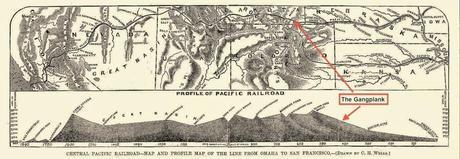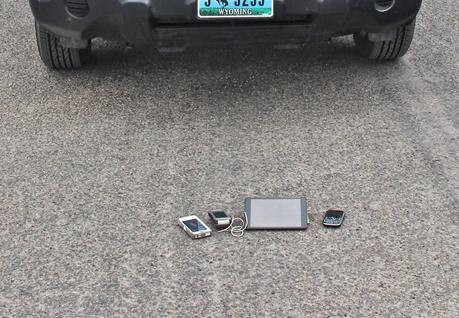 For I know that soon that old four-lane that runs beneath my wheels
For I know that soon that old four-lane that runs beneath my wheelswill take me home to my sweet Wyoming home” ...
 ... IF the highway is open.
... IF the highway is open.
Interstate 80 is open and trucks are again on the move, after being stuck in Laramie, Wyoming.
Why are we here? Why is Laramie located in a basin at 7000 feet elevation in the continental interior well away from any moderating marine influences, and only accessible by highways that cross mountain passes that regularly close in fall, winter and spring? This is the reason:
Geology is destiny.
Laramie was founded in 1868 during construction of the First Transcontinental Railroad. Back then our government was visionary about infrastructure (and lining pockets of influential citizens). A railroad spanning the country would be built! The Central Pacific started in Sacramento, California and worked east, while the Union Pacific worked west from Omaha, Nebraska. The companies didn’t just build, they raced. They would be paid by the mile and the rates were good, so the more miles they could cover before the two lines met, the more money they would make.
Leland Stanford -- California governor, US Senator, railroad magnate (Central Pacific), and eponymous benefactor of my Alma Mater; source.
The Central Pacific had to struggle across California’s Sierra Nevada almost immediately. Then they sped across the Great Basin after Stanford met with Brigham Young and secured crews of Mormon laborers. The Union Pacific made good progress across the Great Plains but then faced the challenge of the Rocky Mountains. Fortunately surveyors had found a relatively easy way across -- a long gradual grade rising from the Great Plains to the summit of the Laramie Mountains. They called it The Gangplank.
Click on image to view details (in 1867, the Laramie Mountains were called the Black Hills); source.
From the crest of the Laramie Mountains the route wound down to the Laramie Basin. The railroad camp there was named Laramie as well. The first train arrived on May 10, 1868, and the next day the line was closed by a snowstorm. Even so, the new town grew to a population of 2000 within two weeks, with most of its citizens arriving by train (source).Laramie is where it is because of the railroad, and the railroad is where it is because of the Gangplank ... but why is there a Gangplank? For that answer, we move into the realm of geological time. In fact we could go back over a billion years to when North America was significantly smaller, but growing as pieces of continents collided with the southern coast, including one not far from Laramie. But it would take quite a few blog posts to get from that Precambrian collision to the creation of the Gangplank. We could go back just 60 million years to the uplift of the Laramie Mountains, but that story is too complicated, puzzling and long to include here. So let’s go back a mere ten million years, to “just yesterday” geologically speaking.
Ten million years ago the Laramie Mountains had been mountains for at least 50 million years. But like all mountains, they were worn down from the get-go ... even as they were being uplifted. Eroded debris was deposited on the flanks for tens of millions of years, eventually burying most of the range.

Block diagrams by B. Mears, Jr., after S.H. Knight; Advanced Geomorphology, U. Wyoming, 1984.
If we had visited the Laramie Mountains ten million years ago, we would have seen small rocky mountains atop long slopes rising from the Great Plains.
The granite peaks at the crest of the range probably never were buried, and remained exposed during Oligocene-Miocene times.
Then (apparently and for reasons that are unclear) the region rose and streams were rejuvenated. Erosion took over, outpacing deposition, and much of the old mountain range was exhumed:

Another of Doc Knight's block diagrams, now an interpretive sign along I-80.

Ten million year old sedimentary rocks lap evenly onto 1.4 billion year old Sherman granite.
The Gangplank is featured at a parking area on Interstate 80 between Cheyenne and Laramie. I hadn’t stopped there for many years; that’s the way it is with things too close to home. “One of these days I’ll stop and take photos for a blog post” I would say -- as I sped on by. The other day we did stop, because the Gangplank is an EarthCache, one of only a few near Laramie. EarthCaches are geocaches, but treasures are provided by the Earth rather than by geocachers. The geocacher provides a description of the treasure, and several questions to be answered to prove one visited and understood:El Tablón (The Plank)
A. Answer the questions in your own words, and to the best of your ability.
1. The large granite rocks to the West of the coordinates are Pre-Cambrian in age. Estimate how old the rocks are in years (Example: Three million)Over a billion (I read the sign). The Sherman granite is on the order of 1.4 billion years old, emplaced after a continental fragment collided with the south coast of North America (see Frost et al. 1999).2. What does erosion mean?“Removal of earth debris (e.g. soil or loose rock) by wind, water and other geological means” was my attempt. Here’s the answer from a real geologist: “Erosion is the general name for the processes that break down rocks (weathering) and the processes that carry away the breakdown products (transportation).”Bonus: B. Post a photo of yourself in the parking lot with the either the plains, the granite rocks, or the informational sign in the background. The pavement does not have to be included in your photo.Here I am by the sign. The sloping surface of the Gangplank shows nicely on the horizon.

Why am I here? because an English botanist recently posted about EarthCaches.

Though not required, here’s a photo of the pavement with tools of modern day explorers.
